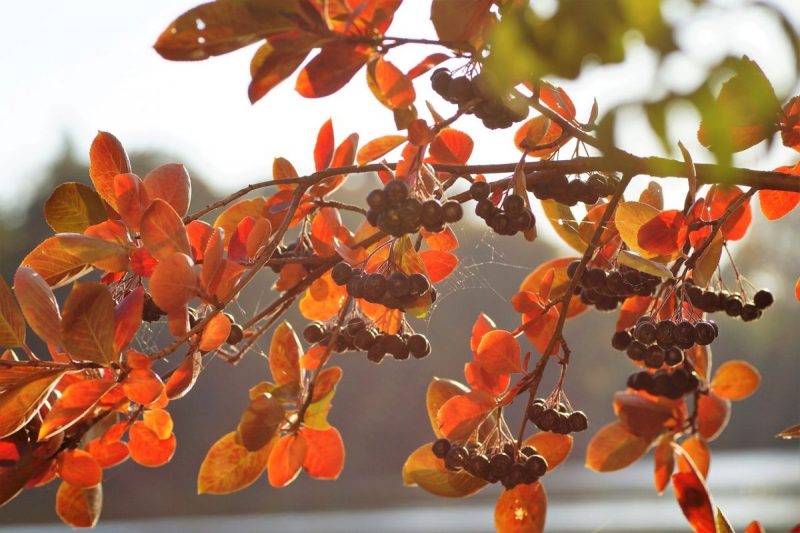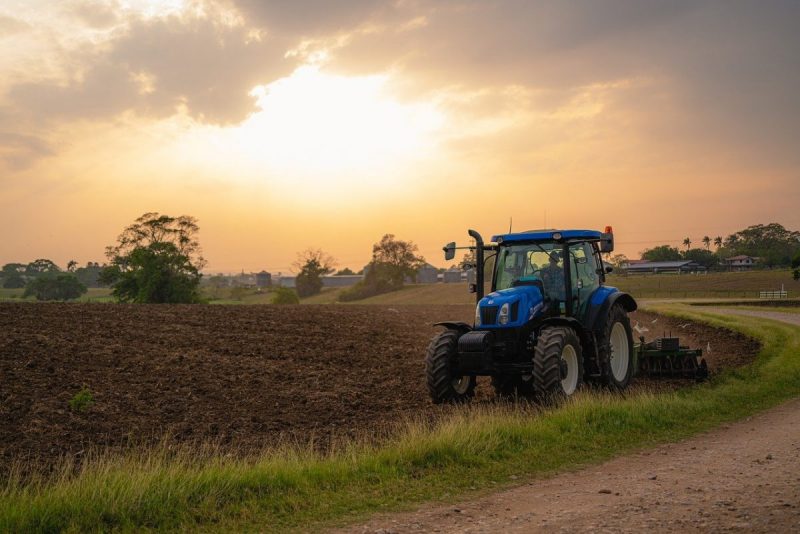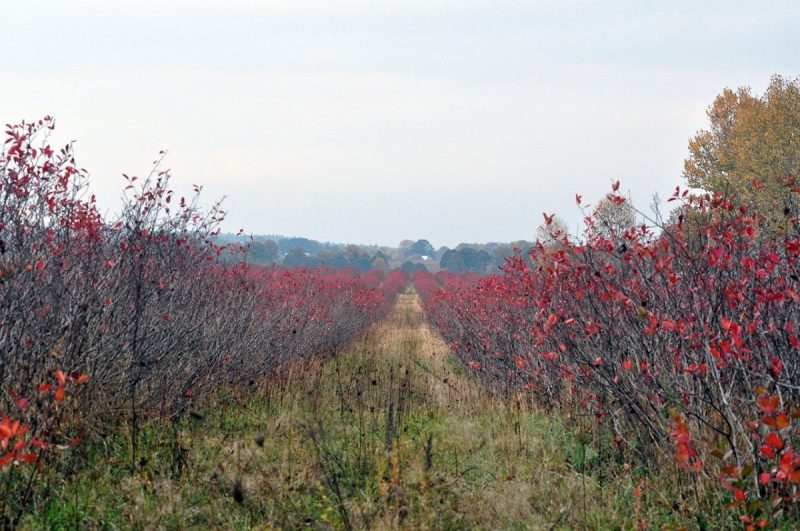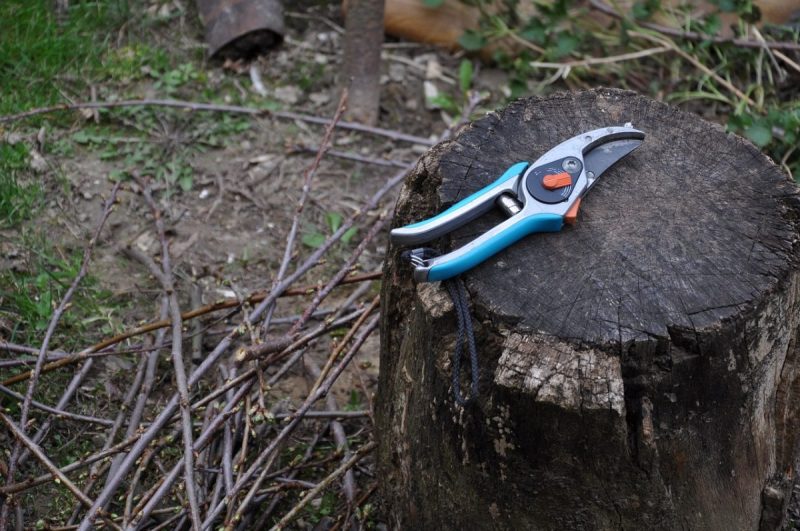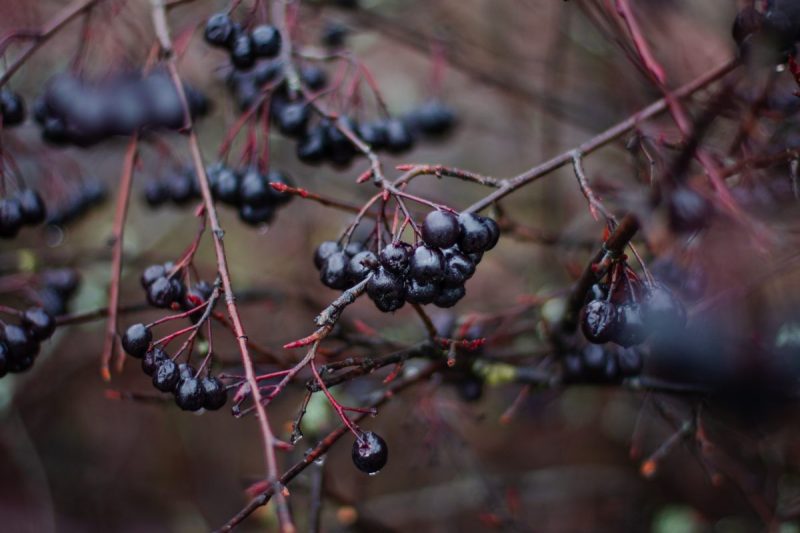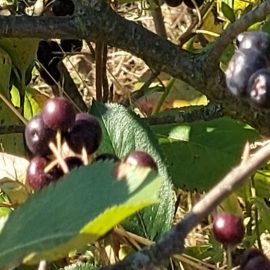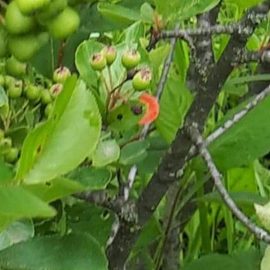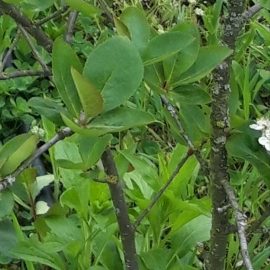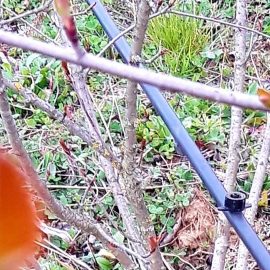Black chokeberry, planting, growing and harvesting
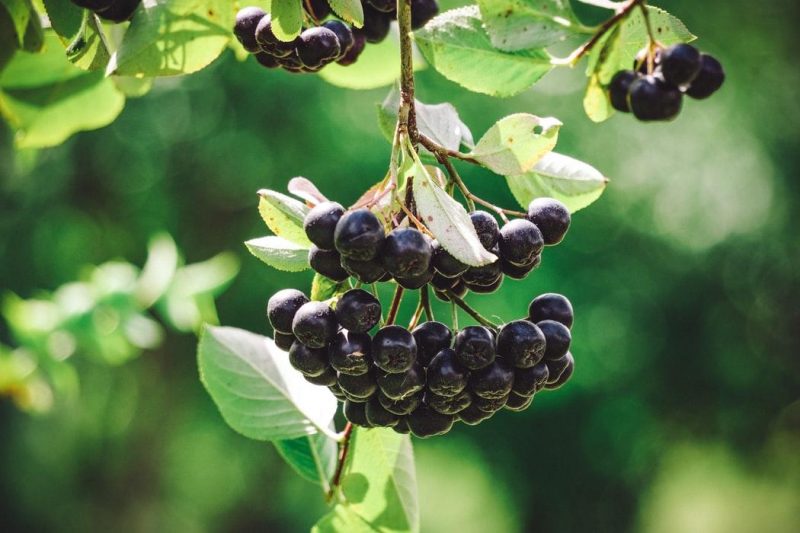
Black chokeberry (Aronia melanocarpa) is a fruit-bearing shrub of the Rosaceae family, native to North America, where it grows spontaneously near forests, in areas with moist, swampy soils.
Black chokeberry has come to the attention of growers because of its fruit’s high content of antioxidants and vitamins, which have beneficial effects on the body. Besides growing for food, black chokeberry is also used for decorative purposes.
Botanical characteristics
Black chokeberry is a rustic, bushy shrub, 1-1.5 meters tall. The crown consists of several brown-gray stems (15-60) with elongated, reddish buds. Flower buds form on branches that are 2-4 years old. The leaves are simple, with serrated edges and elliptical shapes, 3-6 cm long, with a darker color on the topside. In autumn, the leaves turn bright red, having a high aesthetic value. The flowers are white and are clustered in corymb-like inflorescences. Flowering takes place between April and May. Pollination is entomophilous, being a melliferous species. The fruit is a succulent drupe, black or reddish.
Environmental requirements
Aronia can take advantage of a wide range of soils, including slightly acidic and clay soils. It tolerates different pH values, except for basic pH. It is frost-hardy and is not affected by drought. However, if soil moisture is not correlated with environmental factors (irrigation or rainfall), the fruit will shrivel and lose its properties. It is a light-loving species and requires as much sunlight as possible during the day. It also thrives in semi-shade, but yields decrease considerably.
Soil preparation
Choose relatively isolated plots of land, located at least 500 meters from busy roads and at least 12 km from industrial pollutants. The soil must be free of pesticide residues, nitrites, heavy metals, and other pollutants. The slope should not exceed 10-15% and the slopes should not present a risk of erosion (landslides). The highest yields are obtained on soils with a pH between 5.5 and 7.5, rich in humus, with a medium texture. Shrubs should not be planted on salty soils, soils with excess moisture, and stony soils.
The soil preparation starts by removing all plants and plant debris from the plot. If the land is heavily infested with weeds, you can apply a non-selective herbicide. If necessary, level the soil, taking into account the land slope.
Recommended products
-
You can find products on a different store
Change Store -
You can find products on a different store
Change Store -
You can find products on a different store
Change Store -
You can find products on a different store
Change Store -
You can find products on a different store
Change Store -
You can find products on a different store
Change Store -
You can find products on a different store
Change Store -
You can find products on a different store
Change Store -
You can find products on a different store
Change Store -
You can find products on a different store
Change Store -
You can find products on a different store
Change Store -
You can find products on a different store
Change Store -
You can find products on a different store
Change Store -
You can find products on a different store
Change Store -
You can find products on a different store
Change Store -
You can find products on a different store
Change Store -
You can find products on a different store
Change Store -
You can find products on a different store
Change Store -
You can find products on a different store
Change Store -
You can find products on a different store
Change Store -
You can find products on a different store
Change Store -
You can find products on a different store
Change Store -
You can find products on a different store
Change Store -
You can find products on a different store
Change Store
Basic fertilization should be done with NPK complex fertilizer, depending on the soil supply which is determined by soil analysis. After this operation, you can carry out basic plowing at a depth of 30-40 cm. Every 2-3 weeks the soil should be tilled twice with a disc harrow to obtain a good soil texture.
Planting
The soil should be scarified to a depth of 50-60 cm to loosen the deeper soil layers. The work should be carried out immediately after clearing the soil, followed by deep plowing to 35-40 cm.
The optimal planting period is autumn, at the beginning of November. If the operation cannot be carried out in autumn, planting can be carried out in early spring. The recommended planting scheme implies 2.8-3.5 m distances between rows and 1.2-1.5 m distances between plants per row.
After establishing the planting scheme, the land can be picketed. The operation consists of marking the position of each shrub, followed by digging the pits (40 x 40 x 40 cm) and the actual planting.
Before planting, the planting material should be trimmed, removing dry or damaged roots.
For a successful planting, the plant’s roots should be inserted in a slurry of yellow soil, cattle manure, and water.
The plant needs to be positioned so that 5-10 cm of the stem will be covered by soil. After planting, the soil around the shrub must be compacted to ensure good contact between soil and roots and each plant must be irrigated with 4-5 liters of water. It is recommended to mulch the soil with sawdust in strips 1.2 m wide along the row. The gaps between the mulched strips should be grassed or kept clean by repeated discing. Grassing the gaps between the rows should be done from the third year after planting. As a species, you can use white clover (Trifolium repens) or other grass species. The plant material resulting from mowing the grass can be used as mulch.
Maintenance work
Pruning
Pruning is an indispensable work in chokeberry plantations. This technological operation aims to make maintenance work much easier and to stimulate fruit production. In the first years after planting, the crowns must be formed by repeated prunings. Chokeberry has a great capacity to form shoots, which helps in rapid bush formation and periodic branch rejuvenation.
Recommended products
-
You can find products on a different store
Change Store -
You can find products on a different store
Change Store -
You can find products on a different store
Change Store -
You can find products on a different store
Change Store -
You can find products on a different store
Change Store -
You can find products on a different store
Change Store -
You can find products on a different store
Change Store -
You can find products on a different store
Change Store -
You can find products on a different store
Change Store -
You can find products on a different store
Change Store -
You can find products on a different store
Change Store -
You can find products on a different store
Change Store -
You can find products on a different store
Change Store -
You can find products on a different store
Change Store -
You can find products on a different store
Change Store -
You can find products on a different store
Change Store -
You can find products on a different store
Change Store -
You can find products on a different store
Change Store -
You can find products on a different store
Change Store -
You can find products on a different store
Change Store -
You can find products on a different store
Change Store -
You can find products on a different store
Change Store -
You can find products on a different store
Change Store -
You can find products on a different store
Change Store
To manage the plants as a bush, choose 5-8 vigorous main stems from the second year onwards and remove the rest of the growth. Fruit-bearing branches and annual branches will form on the main stems. During the growing season, remove all the leaf litter that has appeared at the base of the bush and carry out annual pruning. After each pruning, the bush must be aerated, have 5-8 main multiannual branches, and the young branches (2-4 years old) must be evenly distributed in the crown.
This shrub can also be managed in the form of a tree, with a 40-50 cm high trunk and a crown formed of 4-5 skeletal stems. In this case, pruning should be carried out 2-3 times during the vegetative period. They consist of removing the shoots that appear at the base of the trunk, rejuvenating the fruit-bearing branches, and removing the overgrown annual branches, those that are broken, affected by disease, or too thin.
After 10-12 years the shrub enters a period of decline and bears less fruit, in which case it is important to carry out rejuvenation pruning. Remove old branches, those affected by disease, and those affected by frost. Branches inserted on multi-annual stems must be thinned and young ones, 2-3 years old, must be kept. Rejuvenation pruning is carried out in stages over 3-4 years.
Fertilization
It can be done with natural fertilizers (manure), applied by incorporation into the soil at 3-4 year intervals. The optimum application period is between November and February. In spring, you can apply slow-release complex fertilizers to each plant.
For foliar application, use specific fertilizers depending on plant needs and environmental conditions.
To help plants overcome periods of stress, carry out foliar or root fertilization with special products for this purpose.
Recommended products
-
You can find products on a different store
Change Store -
You can find products on a different store
Change Store -
You can find products on a different store
Change Store -
You can find products on a different store
Change Store -
You can find products on a different store
Change Store -
You can find products on a different store
Change Store -
You can find products on a different store
Change Store -
You can find products on a different store
Change Store -
You can find products on a different store
Change Store -
You can find products on a different store
Change Store -
You can find products on a different store
Change Store -
You can find products on a different store
Change Store -
You can find products on a different store
Change Store -
You can find products on a different store
Change Store -
You can find products on a different store
Change Store -
You can find products on a different store
Change Store -
You can find products on a different store
Change Store -
You can find products on a different store
Change Store -
You can find products on a different store
Change Store -
You can find products on a different store
Change Store -
You can find products on a different store
Change Store -
You can find products on a different store
Change Store -
You can find products on a different store
Change Store -
You can find products on a different store
Change Store
Irrigation
Irrigation is an important work that ensures optimal development of the plantation in conditions of prolonged drought. In general, irrigation technology involves 4-6 irrigations per season, with a norm of 300-400 cubic meters per hectare. Sprinkler or drip irrigation methods can be used successfully. Drip irrigation offers the advantage of being able to administer water-soluble fertilizers through the system together with the irrigation water.
Pest control is an important link in black chokeberry cultivation technology.
Harvesting chokeberries
Black chokeberry is an early species, bearing fruit from the second year after planting. The Aronia berries can be harvested in late August or early September and are quite resistant to storage. If the production is destined for industrialization, the fruits must be harvested in the middle or even at the end of autumn. The fruit can be processed into juices, jams, phytopharmaceutical preparations, etc.














































































































































































































































































































































































































































